 |
The display
boat shown here was commissioned as a birthday
gift for a long time sailor. |
The display boat shown above was commissioned as
a birthday gift for a long time sailor. The boat is
a hand built, two inches to the foot, model of a 16-foot
Ray Speck Sid skiff. The opportunity to build this
display model was most enjoyable, as I previously
helped build a 14-foot version of the Sid skiff while
attending the wooden boat school at Port Townsend,
Washington in 1999. The boat building school, now
located in Port Hadlock, Washington builds full size
versions of this boat as well as several other fine
wooden boats as student projects.
Sid Foster, Harbormaster of Sausalito, California
owned the original boat, a skiff about 12-1/2’
in length. Ray speck, a master boat builder, instructor,
and author, took the lines off the boat and developed
the plans for a range of boats from 13 to 16 feet
in length. Plans for the full sized boat can be purchase
from Ray Speck by writing to him at: Ray Speck Boat
Building 228 37th St. Port Townsend, Washington 98368
I built my first display boat while attending the
school and have been building selected display boats
of lapstrake workboats from the 1800s. The list now
includes the following boats: 16 foot Whitehall pulling
boat, 16 foot Swampscott sailing dory, 16 foot New
Jersey Sea Bright skiff, 16 foot 7-1/2 inch South
Jersey beach skiff, 12 foot 4-1/2 inch Providence
River fishing boat, and a 16 foot Danish fishing boat.
I build a set of molds from the table of offsets
or bodylines and plank the boats upside down. The
build process is much like that used for full sized
boats with the exception that everything is glued
together. I steam the planks and the oak frames and
cut the gains at the hood ends. An X-Acto knife with
a sharp deburing blade gets a lot of use.
| A Danish fishing
boat was my first display boat. |

|
A Danish fishing boat was my first display boat.
Built from Honduran mahogany, the rudder was carved
from a piece of African Acacia.
 |
Molds and ladder
frame for the South Jersey beach skiff. |
Molds and ladder frame for the South Jersey beach
skiff. The stem, plank keel, keelson, sternpost, deadwood
and transom are mounted on the molds. The garboard
was steamed, glued, and clamped on the keel assembly.
| Centerboard lanyard
secured to cleat on centerboard trunk of Sid skiff. |
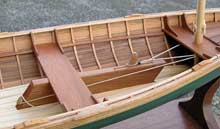
|
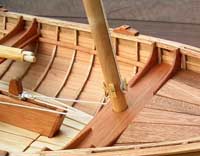 |
Jib halyard
secured to forward cleat on mast of Sid skiff.
|
| African Sapele
fore and aft sheets, Honduran mahogany thwarts
and thwart knees, Monterey pine floorboards, oak
frames, red cedar planking below a birch shear
streak. |
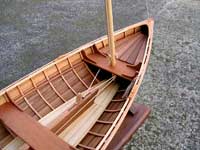
|
A few of the woods used in the construction of the
boats: African Sapele fore and aft sheets, Honduran
mahogany thwarts and thwart knees, Monterey pine floorboards,
oak frames, red cedar planking below a birch shear
streak. The oars are cut and carved from Sitka Spruce.
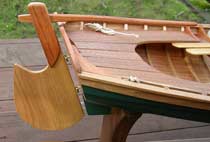 |
Honduran mahogany
tiller and rudder cheeks, cherry rudder. |
| Three piece stem,
sternpost, and deadwood for catboat, cut from
Honduran mahogany. |
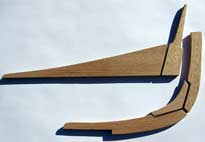
|
If there is a wooden boat that you want to build
full size, one of the best ways to get a feeling for
what is involved in the construction process is to
build a scale model of the boat. I usually build at
two inches to the foot as it makes it easier to cut
a lot of the smaller parts; in addition, you don’t
need a magnifying glass to see the construction details.
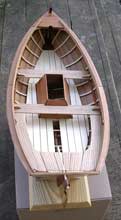 |
First coat of
varnish. |
I am in the process of writing a detailed construction
guide for building lapstrake display boats. It should
be available for purchase in a few weeks.
I also build classic sea chests, sea captains ditty
boxes, and wooden tool chests. If you have any questions
feel free to send me an email at: Larkinsgary@hotmail.com
or visit my website at: www.classicseachests.com
© Copyright 2006, Gary K. Larkins

|